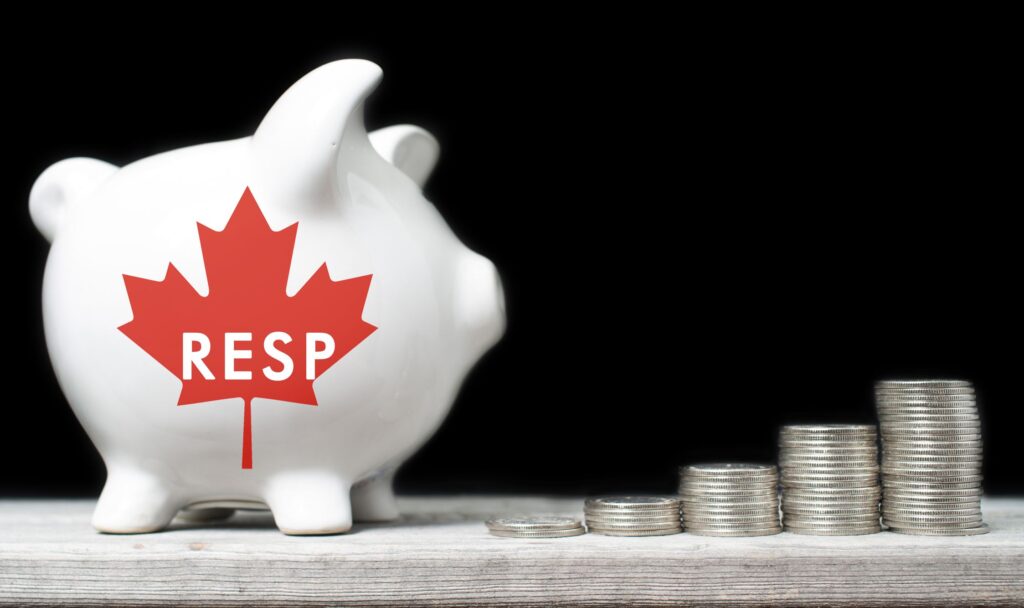Registered Education Savings Plans (RESP)

0%
The sooner you start to save, the sooner you will be earning interest, and the more your money will grow.
As a newcomer in Canada, you may have to familiarize yourself with many aspects of managing your finances and investments. Often, the information you come across may seem overwhelming and leave you feeling confused.
For those moving with family, saving for your kids’ education is often a top financial priority, as post-secondary education costs can be high in Canada. In this article we will dive into RESPs, an investment option for post-secondary education.
What is an RESP?
An RESP is a tax-deferred savings plan that allows subscribers (usually parents) to efficiently save for a beneficiary’s (usually a child’s) education. You can open an RESP without having a bank account.
Key stakeholders in an RESP
- Subscriber: A person who makes contributions to the RESP. If you invest in an RESP, you (or someone acting on your behalf) would be called a subscriber or a contributor.
- Beneficiary: A person (future student) who receives contributions/income from the promoter. While you can open an RESP for a child, you can also name yourself or another adult as the beneficiary.
- Promoter/provider: The entity or institution (e.g. banks, mutual fund companies, scholarship foundations, or trust companies) that pays the contributions and the income earned on those contributions to the beneficiaries.
How does an RESP work?
- A subscriber opens an RESP with a promoter and names one or more beneficiaries under the plan.
- The subscriber makes contributions to the RESP.
- The Canadian government contributes to your RESP through the Canada education savings grant (CESG) and the Canada Learning Bond (CLB).
- RESPs are tax-free as long as the money stays in the savings plan which means the investment income you earn with the plan grows on a tax-deferred basis until it is withdrawn. Upon withdrawal for education purposes, the growth and government grant components are taxed.
- When the beneficiary is ready to start their post-secondary education, they can withdraw from the RESP. Money is provided in the form of educational assistance programs.
- In order to receive CESG or CLB as part of EAP, a beneficiary must be a resident of Canada and have sufficient contributions made into the RESP over the years.
- In the event that a child decides not to attend a post-secondary institution, or doesn’t use the RESP fund entirely, it is possible to add another child to an RESP plan to support their education. Certain rules apply, so be sure to check with your financial advisor.
- As a subscriber, if you withdraw money from your RESP for non-education purposes, the grant component is returned to the government. The remaining money will be taxed at your regular income tax rate, plus an additional 20 per cent. Up to $50,000 CAD can be transferred to your Registered Retirement Savings Plan (RRSP) or your spouse’s RRSP to offset tax liability, as long as you have room for RRSP contributions.
- If you decide to close your RESP, any savings that remain in your RESP when it closes will be handled as follows:
- Money received from either the CESG or CLB will be returned to the government; and
- Any personal savings in the account will be returned to the person who opened the plan.
- Interests earned will be returned to you if all of the following apply:
- All children named in the plan are at least 21 years old and are not eligible for EAP;
- The subscriber is a Canadian resident; and
- The RESP was opened at least 10 years ago.
You should choose an RESP plan that makes sense for your family and accounts for your financial needs in the future. Speak with your financial advisor to decide if a Family plan, Individual plan or Group plan makes the most sense for you.
Are there contribution limits to an RESP?
The Canada Revenue Agency (CRA) registers the RESP and lifetime limits are set by the Income Tax Act on the amount that can be contributed for each beneficiary.
- Currently, there is no annual limit for contributions to RESPs, however, there is a lifetime limit of $50,000 CAD that can be contributed to all RESPs for a beneficiary.
- There is no limit on the number of RESP plans a subscriber can have from different providers.
Tip: Some providers may charge service fees or set limits on how often you can contribute. Before you open an RESP, ask the provider to clearly explain the types of plans, benefits, fees, limits, penalties, payment options, and all other requirements.
The sooner you start to save, the sooner you will be earning interest, and the more your money will grow. Even minimal savings of $5 CAD a week can quickly add up, especially with government contributions.
Who is eligible for an RESP?
The government has outlined the following RESP eligibility criteria:
- Subscriber: Except for family plans, generally, there are no restrictions on who can be the original subscriber under an RESP. Anyone can open an RESP account for a child – parents, guardians, grandparents, other relatives or friends. All subscribers under an RESP have to give their social insurance number (SIN) to the promoter before CRA can register the RESP.
- Beneficiary: A student (beneficiary) can only receive EAPs if they are enrolled in a qualifying educational program. This includes students who are:
- Attending a post-secondary educational institution; or
- Enrolled in distance education courses, such as correspondence courses, provided by such institutions; or
- Who have attained the age of 16 years and are enrolled in a specified educational program.
What student expenses can be covered by an RESP?
RESP funds can be used to pay for tuition or cost of living expenses. They are dispensed in the form of EAPs as follows:
- For studies in a qualifying educational program: $5,000 CAD, for the first 13 consecutive weeks. Beyond the first 13 weeks, there is no limit on the amount of EAPs that can be paid if the student continues to qualify to receive them. If there is a 12-month period in which the student is not enrolled in a qualifying educational program for 13 consecutive weeks, the $5,000 CAD maximum applies again; or
- For studies in a specified educational program: $2,500 CAD, for the 13-week period whether or not the student is enrolled in such a program throughout that 13-week period.
A student can continue to receive EAPs for up to six months after ceasing enrolment, provided that the payments would have qualified as EAPs if they had been made immediately before the student’s enrolment ceased.
For more detailed information about RESPs, see Information about Registered Education Savings Plans published by the government of Canada.
Tags: Retirement, savings, government, benefit
RELATED ARTICLES
| M | T | W | T | F | S | S |
|---|---|---|---|---|---|---|
| 1 | 2 | 3 | 4 | 5 | 6 | 7 |
| 8 | 9 | 10 | 11 | 12 | 13 | 14 |
| 15 | 16 | 17 | 18 | 19 | 20 | 21 |
| 22 | 23 | 24 | 25 | 26 | 27 | 28 |
| 29 | 30 | 31 | ||||
Recent Posts
- Local Immigration Partnership Renfrew and Lanark Counties launch online survey
- CULTURE CONNECT: Local Immigration Partnership and United Way East Ontario secure funding for New Horizons Program
- Pathways – Immigration to Canada
- Almonte resident George Yaremchuk presented with Culture Connector Award
- Inspiring Journey: How an international student from India’s experience in Pembroke is shaping her life and career





Recent Comments